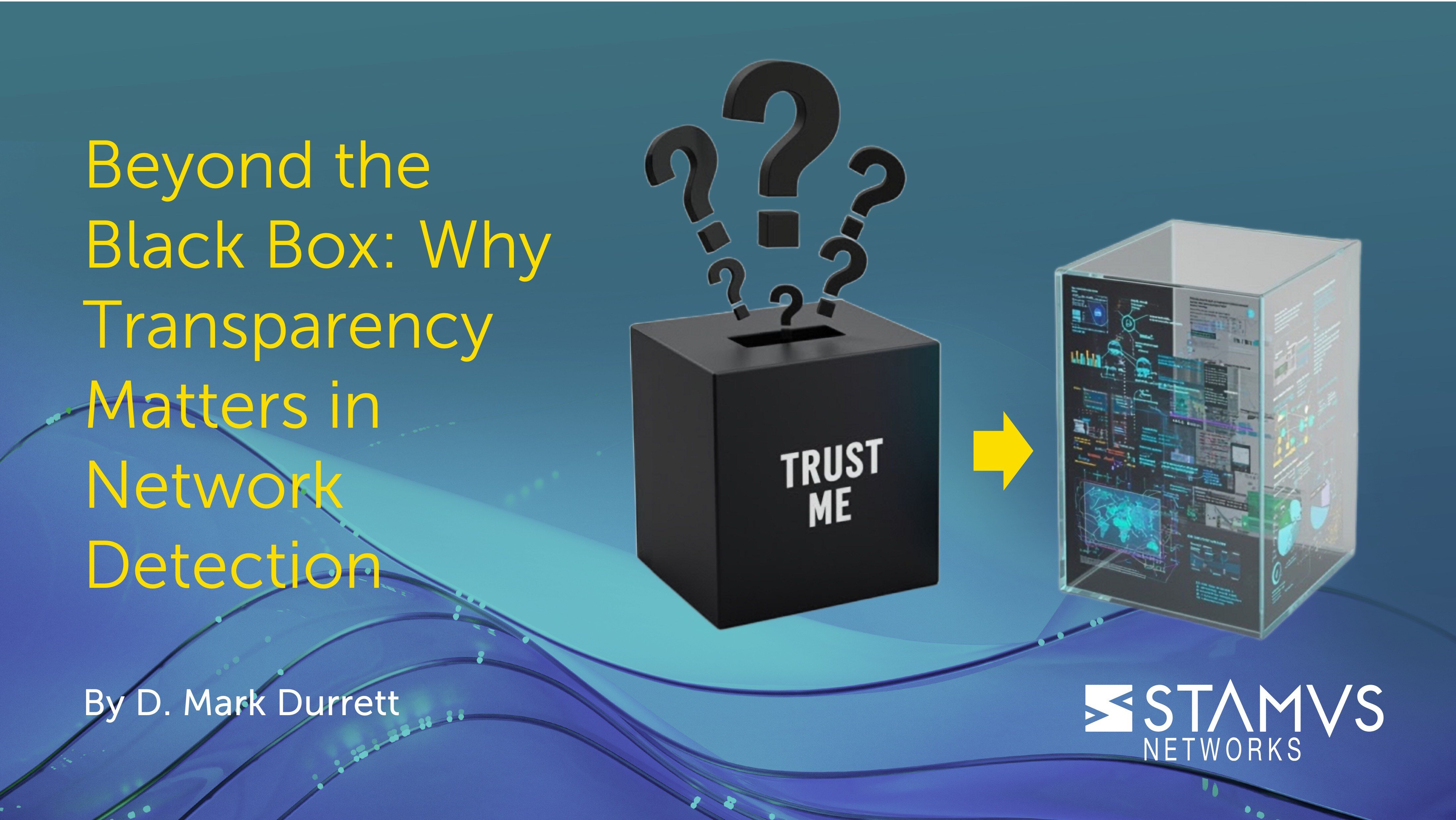For those new to the world of intrusion detection systems (IDS), you may be unaware that there are multiple IDS detection types. Each one differs in how the IDS performs its detections and its source of data. This blog seeks to provide a brief overview of the various types of intrusion detection systems and show the benefits of selecting a network-based IDS or a more modern approach based on a signature-based IDS foundation.
What are the three types of IDS?
There are three main types of IDS/IPS detection: anomaly-based, signature-based, and hybrid. These methods define how the IDS analyzes data to identify potential intrusions.
- Anomaly-Based IDS: Anomaly-based IDS focuses on identifying deviations from normal behavior within a network or system. It works by establishing a baseline for normal activity by statistically analyzing network traffic or system activity over time. This baseline becomes a reference for identifying anomalies. The IDS then continuously monitors network traffic or system activity and compares the real-time data to the established baselines. Significant deviations from these baselines are flagged as potential intrusions.
- Signature-Based IDS: A signature-based intrusion detection system relies on a predefined database of attack signatures to identify malicious activity. These signatures represent known patterns or fingerprints of network attacks or suspicious system behavior. The IDS continuously monitors network traffic or system activity and compares this data against the database of attack signatures. Any matches trigger an alert, indicating a potential intrusion attempt.
- Hybrid IDS: A hybrid intrusion detection system combines both anomaly-based and signature-based detection methods to address the limitations of each approach. A hybrid system leverages signature-based detection for known threats and anomaly-based detection for novel attacks. This enhances the overall effectiveness of intrusion detection.
Each of these three detection methods (Anomaly-based, Signature-based, Hybrid) offers different strengths and weaknesses. Choosing the most suitable approach depends on factors like the specific security requirements of the network, the resource availability for managing the IDS, and the acceptable level of false positives.
What are the different ways to classify an IDS?
There are generally two different ways to classify an IDS based on its deployment and data source:
1. Network-based Intrusion Detection System (NIDS): NIDS act as network monitoring devices deployed at strategic points within a computer network. Their primary function is to continuously capture and analyze network traffic data traversing a specific network segment. NIDS can be implemented in two primary ways:
- Dedicated hardware appliances: These are specialized devices solely designed to perform NIDS functions.
- Software applications on network servers: Existing network servers can be leveraged to host NIDS software, enabling them to perform network traffic analysis alongside other server functionalities.
NIDS typically utilizes network adapter promiscuous mode. This mode allows the NIDS to capture all network traffic on the attached network segment, regardless of its intended recipient. NIDS employs two main techniques for analyzing captured network traffic data: signature-based detection and anomaly-based detection.
2. Host-Based Intrusion Detection System (HIDS): In contrast to NIDS which focuses on network traffic analysis, HIDS provides security for individual devices (hosts) within the network. HIDS function as software agents deployed directly on the operating system of the host device itself. Their primary function is to monitor and analyze activity occurring on the host device. HIDS are deployed as software agents on individual servers, desktops, or laptops within the network. A single HIDS agent is typically installed on each host device for dedicated monitoring.
HIDS collects data from various sources on the host device, including:
- System logs: These logs record events and activities within the operating system of the host device.
- File access attempts: HIDS monitors attempts to access files on the host device, including successful and failed attempts.
- Running processes: HIDS maintains a record of processes currently running on the host device.
HIDS primarily utilizes anomaly-based detection techniques. By analyzing the collected data, HIDS establishes baselines for typical host activity. Significant deviations from these baselines, such as unusual file access attempts or unexpected processes running, can indicate potential intrusions or suspicious behavior.
What are the three components of an intrusion detection system?
Contrary to what some believe, there are really five main components to most types of intrusion detection system:
- Sensors (Data Acquisition Units): These modules function as the primary data collection mechanism for the IDS. They are deployed at strategic points within the network (network sensors) or on individual hosts (host-based sensors). Network sensors continuously capture and transmit network traffic data to the IDS for analysis. Host-based sensors monitor system activity on the device, including logs, file access attempts, and running processes.
- Data Processing and Analysis Engine: The analysis engine is the core component responsible for evaluating data collected by the sensors. It employs various techniques to identify potential intrusions:
- Signature-based Detection: This approach involves matching captured data against a database of known attack signatures. These signatures represent characteristic patterns of malicious activity.
Anomaly Detection: This technique involves employing statistical algorithms to establish baselines for normal network traffic or system activity. The engine then identifies significant deviations from these baselines as potential intrusions.
- Alert Generation Engine: Upon detecting suspicious activity, the analysis engine triggers the alert generation engine. This engine is responsible for formulating alerts that include details of the suspected intrusion, such as the type of activity detected, its timestamp, and the source IP address. These alerts are then disseminated to:
- Security Personnel: For investigation and response actions.
- Security Information and Event Management (SIEM) System: A central repository that aggregates security events from various sources, including IDS alerts, to facilitate a comprehensive view of security posture.
- Management Interface: This software component provides a user interface for security administrators to interact with the IDS. It allows them to:
- Configure the IDS: This involves defining security rules for anomaly detection, managing sensor deployment, and establishing alert thresholds and destinations.
- Monitor System Activity: Security personnel can utilize the console to view real-time data on detected threats, analyze historical data, and investigate security incidents.
*It is important to note that not all IDS has a management interface available
- Knowledge Base: The IDS maintains a repository of critical information for reference and analysis purposes. This knowledge base typically includes:
- Attack Signatures: A well-maintained database of known attack signatures that facilitates signature-based detection.
- Security Rules: Custom rules defined by the security administrator to identify suspicious behavior specific to the organization's network or system.
- Alert History: A chronological record of all generated alerts, including timestamps, details of the detected activity, and the current investigation status.
What are the benefits of NIDS?
Network-based intrusion detection systems (NIDS) offer several advantages in bolstering your network security posture. Here are some key benefits:
- Early Warning and Improved Threat Detection: IDS continuously monitors for suspicious activity. By identifying potential intrusions early on, IDS provides valuable lead time for security personnel to investigate and respond before attackers can inflict significant damage. This can help prevent data breaches, unauthorized access attempts, and the spread of malware.
- Enhanced Security Visibility: IDS offers a broader view of security threats across your network. NIDS provides insights into network traffic patterns, helping to identify potential vulnerabilities and malicious activity targeting your network infrastructure.
- Improved Incident Response: The early warnings and detailed information provided by IDS can significantly streamline incident response efforts. Security personnel can leverage IDS alerts to prioritize threats, expedite investigations, and take appropriate actions to contain and mitigate security incidents.
- Compliance and Regulatory Requirements: Many industries and regulations mandate organizations to implement security measures for data protection. IDS can play a crucial role in demonstrating compliance with these regulations by providing audit trails and logs of detected security events.
- Defense-in-Depth Approach: IDS is a vital component of a layered security defense strategy. They complement other security measures like firewalls and access controls by providing an additional layer of intrusion detection and threat analysis. This layered approach strengthens your overall security posture and makes it more difficult for attackers to gain access to your systems.
- Reduced Risk of Data Breaches: By proactively identifying and in some cases blocking threats, IDS can significantly reduce the risk of data breaches. Early detection allows you to isolate compromised systems and prevent attackers from exfiltrating sensitive data.
It's important to note that IDS is not foolproof. These systems can generate false positives and may not be able to detect all types of attacks. However, the benefits they offer in terms of early threat detection, improved visibility, and enhanced security response make them a valuable tool for any organization looking to strengthen its cybersecurity defenses.
Explore a modern alternative
You need a network security platform that doesn’t generate an endless stream of useless alerts across part of your network, and instead automatically identifies alerts of interest and notifies you of only serious and imminent threats. Your organization deserves response-ready detection with visibility into your entire network regardless of the environment with easy access to all the contextual evidence you need to stop an attack before it can cause damage. Replace your legacy IDS with a modern network detection and response platform that gives you these features and more.
The Stamus Security Platform™ is a network-based threat detection and response solution that eliminates the challenges of legacy IDS while lowering your response time. Stamus Security Platform harnesses the full potential of your network, bringing state-of-the-art threat detection, automated event triage, and unparalleled visibility to the security team.
Book a demo to see if the Stamus Security Platform is right for your organization.
To learn more about replacing your legacy IDS, check out the following resources:
To be notified of new blog posts and other news, make sure to subscribe to the Stamus Networks blog, follow us on Twitter, LinkedIn, and Facebook, or join our Discord.






